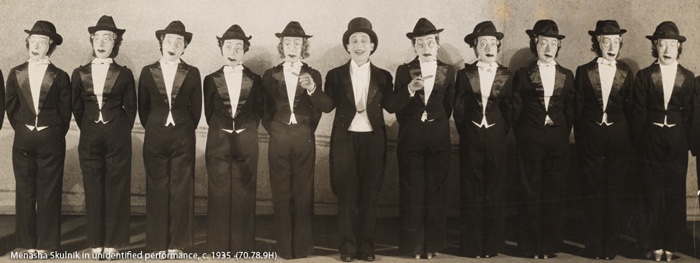Pogroms to Producers: A New Look at 135 Years of Yiddish Theater

Much of American business in the early days of the twentieth century was determined by the size of the immigrant waves that arrived here. One of the most interesting was the wave of Jewish immigrants who fled Russia just in front of the hooves of the czar’s cavalry prior to World War I. They settled in New York City in huge numbers. They did not know English and needed some entertainment.
As always in America, there was someone there to provide it for the Jews – the Yiddish Theater.
The Yiddish theater began in the 1880s and by 1920 there were fourteen major Jewish theaters in New York City, most in the Lower East Side in the Second Avenue/Bowery area. They were so successful that in 1900, when the city had half a million Jewish residents, the theaters sold over a million tickets.
The story of the Yiddish theater is chronicled in “New York’s Yiddish Theater from the Bowery to Broadway,” a new, absorbing and enriching exhibit at the Museum of the City of New York, at 1220 Fifth Avenue (at 103rd Street), where visitors can step through a large door to an exhibit full of huge photos, lots of videos of plays, sheet music, costumes and magazines. The museum has done a wonderful job of bringing the history of the Jewish theater to life and to do it in a way that makes you a part of it, strolling down the lower east side yourself, straw hat in hand and a toe tapping to the music of the theaters nearby.
The exhibit showers you with memorabilia of the Yiddish Theater, with 250 posters, dozens of old playbills, ticket stubs and photos, but it also shows you the connection between the ethnic theater and modern theater, which used the Yiddish troupes as part of its foundation. As an example, there are biographies, exhibits and photos on Yiddish stars such as Paul Muni and Molly Picon, who made the transition to mainstream theater. There is Barbra Streisand’s gray and lavender gown from the musical Funny Girl, Zero Mostel’s Tevye costume from the musical Fiddler on the Roof, back again on Broadway, by the way. There is even a photo of a young Frank Sinatra looking at a poster of Jewish actor Menashe Skulnick. Edward G. Robinson starred in Yiddish productions. Jacob Adler was a star, as was his daughter Stella, who later founded the Stella Adler acting school, among whose alumni are Robert DeNiro and Warren Beatty.
The exhibit, curated by Edna Nahshon, shows the development of Jewish theater chronologically from 1882 onwards and, in those years, the explosive growth of the art form. She has used pieces of memorabilia from the museum’s collection and the YIVO Institute for Jewish Research. She reminds you, too, in many of the exhibit sections, how impressive the shows were and how magnificent the theaters. The theaters on Second Avenue, she said in an identification card, cost an average of $1 million each, pretty expensive for the era.
The exhibit starts with a mammoth photograph of the Grand Theater and long lines of well-dressed people outside of it. You get the impression that the World Series is there. The Grand, and other venues along Second Avenue, produced a lot of simplistic dramas at first, but later staged musicals as good as some on Broadway – in Yiddish.
What is stunning about the exhibit is the lengthy and well preserved collection of film clips of plays (with English subtitles). They not only show the quality of the productions but the skill of the Jewish actors. There are several such collections. There is an impressive collections of mens' and womens' costumes from the era and a striking group of photos showing uniformed GIs gathering about Yiddish theaters on Second Avenue. There is one section devoted to the political plays written and staged in the 1920s and 1930s, such as Miracle of the Warsaw Ghetto in 1944.
There were Yiddish superstars, like Boris Thomashefsky, who was so successful that he had two homes, a Japanese cook and two women – one his wife and the other his girlfriend. When one Jewish superstar died, tens of thousands of people attended his funeral.
By the end of World War II, most Jewish immigrants in New York knew how to speak English and the need for Yiddish theater declined rapidly. Some actors went to work in the Catskills hotels in variety shows, but not many. The number of theaters shrunk and today there is just one of them left. The one remaining theater is not a sad commentary on the decline of Yiddish theater, but a triumphant commentary of how the Jews were assimilated into mainstream theater world and American life where, like all the other immigrants, they provide marvelous entertainment today for all of America.
The exhibit runs through July 31.